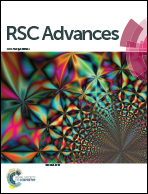A novel single-phase warm white emission phosphor Sr3YAl2O7.5:Bi3+,Eu3+ with energy transfer for UV white LEDs
Abstract
A novel phosphor Sr3YAl2O7.5:xBi3+,yEu3+ was successfully synthesized through a high temperature solid-state reaction. The crystal structure, photoluminescence properties, fluorescence decay and thermal quenching properties have been measured and analyzed. The energy transfer mechanism is demonstrated to be a dipole–dipole interaction and the critical distance between the Bi3+ and Eu3+ has been calculated. The emission spectra of the Sr3YAl2O7.5:Bi3+,Eu3+ phosphors present a blue-green emission of Bi3+ ions with three broad bands at 370 nm, 410 nm and 505 nm and many characteristic emission lines of Eu3+ ions, deriving from the allowed 3P1–1S0 transition of the Bi3+ ion and the 5D0–7Fj transition of the Eu3+ ion. By changing the ratio of Bi3+ concentration and Eu3+ concentration, we can get a warm white light under ultraviolet excitation. The results give the Commission International deL'Eclairage (CIE) chromaticity coordinates for the white LED as (0.3794, 0.3453) and a correlated color temperature of 3731 K, and the integrated emission intensity at 150 °C remains 66.4% of that measured at room temperature, which indicates that the SYAO:Bi3+,Eu3+ phosphor is a very promising candidate for use as a warm UV white light-emitting diode (WLED) phosphor.


 Please wait while we load your content...
Please wait while we load your content...